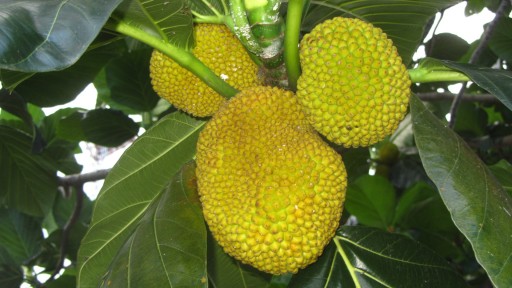Once upon a time breadfruit (Artocarpus altilis) was the staple diet of many island nations in Polynesia and other parts of the vast South Pacific region. There was even a saying in Tahiti that the very first thing one should do after building a house is to plant a breadfruit tree (or an “uru” as they call it in that part of the world) – that way there will always be food to put on the table. This strong, stately tree can reach over 25 metres in height and the largest specimen may produce as many as 200 fruits per season. Some interesting preservation techniques, developed by the Polynesians, ensured year-round availability and full stomachs even during droughts, cyclones and other natural disasters. Sadly, this food is fast being displaced by more “normal” alternatives, such as potatoes or rice.
If you believe that breadfruit is basically “bread” that grows on a tree then you are seriously mistaken. In fact, I have always wondered why the early European explorers gave the fruit such a ridiculously misleading name. Breadfruit doesn’t resemble bread in shape, taste, colour or composition. The idea that one could simply walk to her garden, pick a breadfruit from the tree, slice it and have it for breakfast was probably just part of the idealisation of the South Seas that many Europeans chose to believe back in the 17th century. In many ways, breadfruit, a starchy produce, is actually closer to potato. It is normally eaten cooked or baked, with salt, spices and gravy added before it is served – otherwise it’s just too bland and barely palatable. Just like a potato.
Of course, breadfruit served as a backdrop of the most famous naval mutiny that took place in 1789 on HMS Bounty. Captained by Lieutenant William Bligh, the ship was sent to Tahiti to collect breadfruit tree seedlings which were to be transported to the West Indies and eventually serve as the main source of food for African slaves in the colonies. But after enjoying six months of care-free lifestyle in Tahiti, some members of the crew decided that staying with the friendly islanders would be a much more pleasant option than continue sailing the high seas in miserable conditions for a miserable pay – and they took the ship. Most of the mutineers, including the leader Fletcher Christian, eventually settled on the island of Pitcairn where their descendants (about 50 people) live to this day.
In Taiwan, breadfruit trees, with their large and unique leaves, are very common throughout the island, although they rarely produce any fruit. This is apparently due to the wider than acceptable temperature swings around here where many younger or weaker trees will only develop flowers, but no fruit. There are some exceptions, however – the first picture below was taken not far from our property where an enormous breadfruit tree keeps producing (smallish) fruits year after year. The second picture was captured on the island of Nuku Hiva in French Polynesia.
(This page has been viewed 1090 times.)




